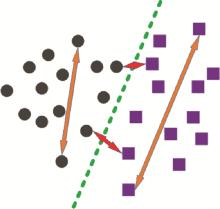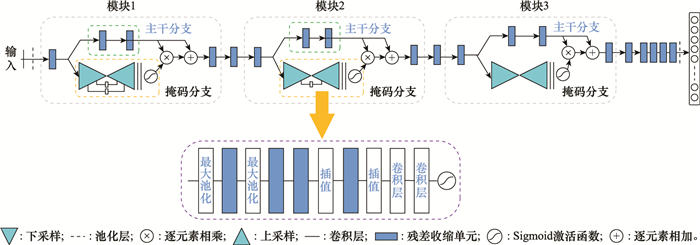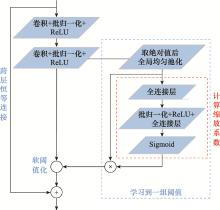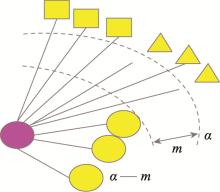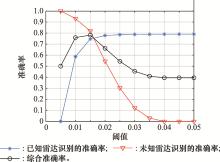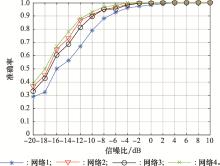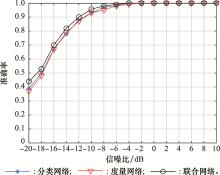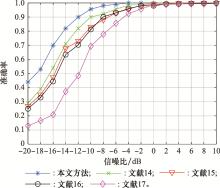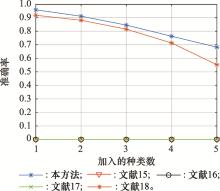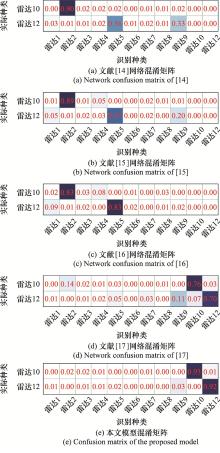Systems Engineering and Electronics ›› 2023, Vol. 45 ›› Issue (3): 717-725.doi: 10.12305/j.issn.1001-506X.2023.03.12
• Sensors and Signal Processing • Previous Articles Next Articles
Radar signal recognition method based on deep residual shrinkage attention network
Pengyu CAO1,*, Chengzhi YANG1, Zesheng CHEN1, Lu WANG2, Limeng SHI3
- 1. School of Air Operations and Services, Aviation University of Air Force, Changchun 130022, China
2. School of Aeronautical Foundation, Aviation University of Air Force, Changchun 130022, China
3. Unit 93671 of the PLA, Nanyang 474350, China
-
Received:2021-05-18Online:2023-02-25Published:2023-03-09 -
Contact:Pengyu CAO
CLC Number:
Cite this article
Pengyu CAO, Chengzhi YANG, Zesheng CHEN, Lu WANG, Limeng SHI. Radar signal recognition method based on deep residual shrinkage attention network[J]. Systems Engineering and Electronics, 2023, 45(3): 717-725.
share this article
Table 1
Known radar signal parameter settings"
| 标签 | 雷达序号 | 调制方式 | 信号参数 | 取值 |
| 0 | 1 | CW | 载频/MHz | 330 |
| 1 | 2 | LFM | 起始频率/MHz 带宽/MHz | [250, 300] 40 |
| 2 | 3 | BPSK | 载频/MHz 编码方式 | 300 13位巴克码 |
| 3 | 4 | QPSK | 载频/MHz 编码方式 | 400 格雷码 |
| 4 | 5 | P1 | 载频/MHz 步进频率/MHz | [250, 300] {4, 7} |
| 5 | 6 | P2 | 载频/MHz 步进频率/MHz | [250, 300] {4, 6} |
| 6 | 7 | P3 | 载频/MHz 步进频率/MHz | [250, 300] {4, 6, 7} |
| 7 | 8 | P4 | 载频/MHz 步进频率/MHz | [250, 300] {7, 8} |
| 8 | 9 | P1 | 载频/MHz 步进频率/MHz | [350, 400] {4, 7} |
| 1 |
WANG Q S , BAI J , HUANG X Y , et al. Analysis of radar emitter signal sorting and recognition model structure[J]. Procedia Computer Science, 2019, 154, 500- 503.
doi: 10.1016/j.procs.2019.06.076 |
| 2 |
XU X , WANG W , WANG J H . A three-way incremental-learning algorithm for radar emitter identification[J]. Frontiers of Computer Science, 2016, 10 (4): 673- 688.
doi: 10.1007/s11704-015-4457-7 |
| 3 | ZHANG C H , HAN Y T , ZAHNG P , et al. Research on modern radar emitter modelling technique under complex electromagnetic environment[J]. The Journal of Engineering, 2019, (20): 7134- 7138. |
| 4 | HE M, MAO Y, HAN J. A method of extracting radar inpulse characteristics in low SNR[C]//Proc. of the IEEE International Conference on Signal Processing, 2007. |
| 5 | SHEN J H , HUANG J C , ZHU Y C , et al. Overview of radar signal fast recognition[J]. Electronic Information Warfare Technology, 2017, 32 (5): 5- 10. |
| 6 |
LI Y B , GE J , LIN Y , et al. Radar emitter signal recognition based on multi-scale wavelet entropy and feature weighting[J]. Journal of Central South University, 2014, 21 (11): 4254- 4260.
doi: 10.1007/s11771-014-2422-5 |
| 7 |
LI L , JI H B . Radar emitter recognition based on cyclostationary signatures and sequential iterative least-square estimation[J]. Expert Systems with Applications, 2011, 38 (3): 2140- 2147.
doi: 10.1016/j.eswa.2010.07.155 |
| 8 |
O'SHEA T J , ROY T , CLANCY T C . Over the air deep learning based radio signal classification[J]. IEEE Journal of Selected Topics in Signal Processing, 2018, 12 (1): 168- 179.
doi: 10.1109/JSTSP.2018.2797022 |
| 9 |
WANG S H , PHILLIPS P , SUI Y , et al. Classification of Alzheimer's disease based on eight-layer convolutional neural network with leaky rectified linear unit and max pooling[J]. Journal of Medical Systems, 2018, 42 (5): 85.
doi: 10.1007/s10916-018-0932-7 |
| 10 |
YUAN X Y , HE P . Adversarial examples: attacks and defenses for deep learning[J]. IEEE Trans.on Neural Networks and Learning Systems, 2019, 30 (9): 2805- 2824.
doi: 10.1109/TNNLS.2018.2886017 |
| 11 | HE K M, ZHANG X Y, REN S Q, et al. Delving deep into rectifiers: surpassing human-level performance on ImageNet classification[C]//Proc. of the IEEE International Conference on Computer Vision, 2015: 1026-1034. |
| 12 | 刘赢, 田润澜, 王晓峰. 基于深层卷积神经网络和双谱特征的雷达信号识别方法[J]. 系统工程与电子技术, 2019, 41 (9): 1998- 2005. |
| LIU Y , TIAN R L , WANG X F . Radar signal recognition method based on deep convolutional neural network and bispectrum feature[J]. Systems Engineering and Electronics, 2019, 41 (9): 1998- 2005. | |
| 13 | 张怡霄, 郭文普, 康凯, 等. 基于聚类和时序相关的重点雷达信号快速识别[J]. 系统工程与电子技术, 2020, 42 (3): 597- 602. |
| ZHANG Y X , GUO W P , KANG K , et al. Key radar signal fast recognition method based on clustering and time-series correlation[J]. Systems Engineering and Electronics, 2020, 42 (3): 597- 602. | |
| 14 |
秦鑫, 黄洁, 查雄, 等. 基于扩张残差网络的雷达辐射源信号识别[J]. 电子学报, 2020, 48 (3): 456- 462.
doi: 10.3969/j.issn.0372-2112.2020.03.006 |
|
QIN X , HUANG J , ZHA X , et al. Radar emitter signal recognition based on dilated residual network[J]. Acta Electronica Sinica, 2020, 48 (3): 456- 462.
doi: 10.3969/j.issn.0372-2112.2020.03.006 |
|
| 15 | 郭立民, 寇韵涵, 陈涛, 等. 基于栈式稀疏自编码器的低信噪比下低截获概率雷达信号调制类型识别[J]. 电子与信息学报, 2018, 40 (4): 875- 881. |
| GUO L M , KOU Y H , CHEN T , et al. Low probability of intercept radar signal recognition based on stacked sparse auto-encoder[J]. Journal of Electronics & Information Technology, 2018, 40 (4): 875- 881. | |
| 16 |
QU Z H , HOU C F , HOU C G , et al. Radar signal intra-pulse modulation recognition based on convolutional neural network and deep Q-Learning network[J]. IEEE Access, 2020, 8, 49125- 49136.
doi: 10.1109/ACCESS.2020.2980363 |
| 17 | 石礼盟, 杨承志, 吴宏超. 基于深层残差网络和三元组损失的雷达信号识别方法[J]. 系统工程与电子技术, 2020, 42 (11): 2506- 2512. |
| SHI L M , YANG C Z , WU H C . Radar signal recognition method based on deep residual network and triplet loss[J]. Systems Engineering and Electronics, 2020, 42 (11): 2506- 2512. | |
| 18 | ZHAO M N , ZHONG S S , FU X Y , et al. Deep residual shrinkage networks for fault diagnosis[J]. IEEE Trans.on Industrial Informatics, 2020, 16 (7): 4681- 4690. |
| 19 | WANG F, JIANG M Q, QIAN C, et al. Residual attention network for image classification[C]//Proc. of the IEEE Conference on Computer Vision and Pattern Recognition, 2017. |
| 20 | HU J , SHEN L , ALBANIE S , et al. Squeeze-and-excitation networks[J]. IEEE Trans.on Pattern Analysis and Machine Intelligence, 2020, 42 (8): 2011- 2023. |
| 21 | HE K M, ZHANG X Y, REN S Q, et al. Deep residual learning for image recognition[C]//Proc. of the IEEE Conference on Computer Vision & Pattern Recognition, 2016. |
| 22 | SCHROFF F, KALENICHENKO D, PHILBIN J. FaceNet: a unified embedding for face recognition and clustering[C]//Proc. of the IEEE Conference on Computer Vision and Pattern Recognition, 2015: 815-823. |
| [1] | Qingyuan ZHAO, Zhiqiang ZHAO, Chunmao YE, Yaobing LU. Micro-motion fusion recognition of double band early warning radar based on self-attention mechanism [J]. Systems Engineering and Electronics, 2023, 45(3): 708-716. |
| [2] | Xiaojia YAN, Weige LIANG, Gang ZHANG, Bo SHE, Fuqing TIAN. Prediction method for mechanical equipment based on RCNN-ABiLSTM [J]. Systems Engineering and Electronics, 2023, 45(3): 931-940. |
| [3] | Xiao HAN, Shiwen CHEN, Meng CHEN, Jincheng YANG. Open-set recognition of LPI radar signal based on reciprocal point learning [J]. Systems Engineering and Electronics, 2022, 44(9): 2752-2759. |
| [4] | Xiaofeng ZHAO, Yebin XU, Fei WU, Jiahui NIU, Wei CAI, Zhili ZHANG. Ground infrared target detection method based on global sensing mechanism [J]. Systems Engineering and Electronics, 2022, 44(5): 1461-1467. |
| [5] | Pingliang XU, Yaqi CUI, Wei XIONG, Zhenyu XIONG, Xiangqi GU. Generative track segment consecutive association method [J]. Systems Engineering and Electronics, 2022, 44(5): 1543-1552. |
| [6] | Pengyu CAO, Chengzhi YANG, Limeng SHI, Hongchao WU. Unknown radar signal processing based on PSO-DBSCAN and SCGAN [J]. Systems Engineering and Electronics, 2022, 44(4): 1158-1165. |
| [7] | Tao WU, Lunwen WANG, Jingcheng ZHU. Camouflage image segmentation based on transfer learning and attention mechanism [J]. Systems Engineering and Electronics, 2022, 44(2): 376-384. |
| [8] | Tao JIN, Xiaofeng WANG, Runlan TIAN, Xindong ZHANG. Rapid recognition method of radar emitter based on improved 1DCNN+TCN [J]. Systems Engineering and Electronics, 2022, 44(2): 463-469. |
| [9] | Yutang MA, Peng SUN, Jieyong ZHANG, Peng WANG, Yunfei YAN, Liang ZHAO. Air group intention recognition method under imbalance samples [J]. Systems Engineering and Electronics, 2022, 44(12): 3747-3755. |
| [10] | Yiqiang TANG, Xiaopeng YANG, Shengming ZHU. Low-orbit satellite channel prediction algorithm based on the hybrid CNN-BiLSTM using attention mechanism [J]. Systems Engineering and Electronics, 2022, 44(12): 3863-3870. |
| [11] | Lingzhi QU, Junan YANG, Hui LIU, Keju HUANG. Method for individual identification of communication radiation source embedded in attention mechanism [J]. Systems Engineering and Electronics, 2022, 44(1): 20-27. |
| [12] | Ziyan LIU, Shanshan MA, Jing LIANG, Mingcheng ZHU, Lei YUAN. Attention mechanism based CNN channel estimation algorithm in millimeter-wave massive MIMO system [J]. Systems Engineering and Electronics, 2022, 44(1): 307-312. |
| [13] | Bangyan CUI, Runlan TIAN, Dongfeng WANG, Gang CUI, Jingyuan SHI. Radar emitter identification based on attention mechanism and improved CLDNN [J]. Systems Engineering and Electronics, 2021, 43(5): 1224-1231. |
| [14] | Anran FANG, Dan LI, Jianqiu ZHANG. Outlier and unknown observation noise robust Kalman filter [J]. Systems Engineering and Electronics, 2021, 43(3): 593-602. |
| [15] | Shiyang GAO, Huixu DONG, Runlan TIAN, Xindong ZHANG. Radar emitter signal recognition method based on SRNN+Attention+CNN [J]. Systems Engineering and Electronics, 2021, 43(12): 3502-3509. |
| Viewed | ||||||
|
Full text |
|
|||||
|
Abstract |
|
|||||
